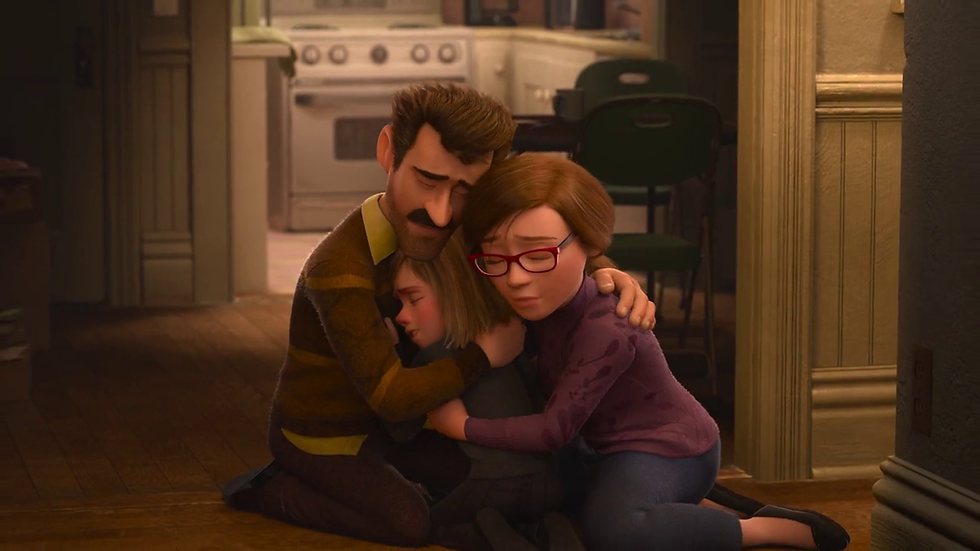Inside Out (2015)
- nickkarner
- Sep 14, 2022
- 10 min read

Growing up, Bill Watterson’s “Calvin and Hobbes” comic strip was a big deal. It’s still a big deal, evidenced by the fact that while I’ve liquidated a great deal of books and gone the digital route, I’ve kept my C&H collection books. One particular strip fascinated me. It depicted hundreds of tiny Calvin’s running around in some sort of factory setting. The punchline was that these mini-Calvin's are operating inside Calvin’s body, keeping it moving and shaking. This concept served as the inspiration for the fourth short film I made in film school, A Tasteful Holiday. It’s pretty rough and amateurish, but it was certainly ambitious. Upon revisiting Pixar’s Inside Out, which I hadn’t seen since it’s theatrical run in 2015, I was struck by the daring, bold originality of the film’s vision. What if there really are literal manifestations of feelings living inside us and they’re constantly at odds, both working with and against each other? The use of caricatures is often maligned as a lazy conceptualization by a writer which can come off as downright offensive if done wrong. Here, these specific traits are a necessity as each emotion is in charge of one facet of main character Riley (Kaitlyn Dias)’s personality. Co-director/co-writer Pete Docter’s delightfully inventive and (literally) emotionally-draining film couldn’t have come at a more important time in the Pixar Animation Studio’s history.

It doesn’t need to be stated how important Pixar is to the world of animation. It’s the gold standard to which most other American studios strive to achieve, and even international production companies, including the mighty Studio Ghibli, still nod their head in approval despite Ghibli's obvious influences on Pixar in the first place. Still, what goes Up (pun intended), must come down. Pixar’s run, beginning with Toy Story and including, but not limited to, Finding Nemo, The Incredibles, Ratatouille, Cars, WALL-E, and culminating in the quietly powerful Toy Story 3 represented a 15-year hot streak that is one of the most impressive in all of cinematic history. After TS3, things suddenly took a subtle, but obvious downturn. The release of Cars 2 signaled quite a few red flags and Brave was a solid effort that suffered from a notoriously troubled production. Monsters University once again felt like an act of desperation as a studio known for fresh ideas appeared to be running dry. Leave it to the most unassuming of the original Pixar animation directors to bring the company roaring back to its glory.

Incredibles writer/director Brad Bird made a successful leap from animation to live-action filmmaking with MI4: Ghost Protocol. The same can’t be said for Nemo and WALL-E director Andrew Stanton, who reportedly became something of a megalomaniac while making John Carter, a grand scale failure that’s much more enjoyable than its reputation suggests but suffers from a lack of heart and bland execution. Cars and original Toy Story director John Lassetter...well, you know. Editor-turned-director Lee Unkrich has remained relatively unscathed due to his co-directing work on Toy Story 2, Finding Nemo, and his solo efforts on Toy Story 3. He’d rise even higher with the lovely Coco in 2017. His work as co-director on Monsters Inc. (along with frequent Simpsons director David Silverman) is immeasurably important, but we all know who the driving force behind Monsters Inc., Up, and Inside Out was.

Pete Docter has proved himself to be one of the most creative writers of the last few decades. As a scribe on the first two Toy Story films and WALL-E (all of which he received an ‘original story’ credit for), this is a man whose flights of fancy fortunately belong in the world of animation where they can be fully fleshed-out and realized. Monsters Inc. was a fanciful and luckily successful idea which kept the Pixar train rolling, but it was with Up that he truly broke through; exploring themes of age and loss and delivering what is widely regarded as one of the greatest and most heartbreaking opening sequences ever conceived. While all of Pixar’s film have fantastical elements, many of them either revolved around your standard talking animals/insects (Finding Nemo, A Bug’s Life), talking machines (Cars), or people in fanciful situations (The Incredibles, Brave, Ratatouille). From 2010 to 2015, things looked dark for Pixar, but then Docter’s kooky idea machine started whirring and, thanks to the changes in his daughter’s outlook and personality, we were gifted a film unlike anything the studio had created before.

One can trace the evolution of celebrity voice-over work back to Robin Williams’ legendary appearance as the Genie in Aladdin. Prior to this, there had been plenty of animated films with famous people giving voice to kooky characters (Eva Gabor and Bob Newhart in The Rescuers are good examples), but never before had a company, in this case Disney, plastered the name of their big celebrity “get” all over their ad campaign. Of course, this was all against Williams’ wishes, which caused a major rift between the comedy superstar and the corporate giant which was only mended many years later after a heartfelt apology from studio chief Joe Roth. Since then, incredibly versatile but relatively unknown voice-over artists have had to take a back seat to A-listers and comedians whose names provide more marquee value. Pixar is one of those rare studios which goes for more “outside the box” thinking. They’ll often cast for acting skill and/or how appropriate an actor is for a character rather than how famous they are. For Inside Out, Docter and his co-director/co-writer Ronnie Del Carmen assembled their core cast based on both the performer’s versatility and in some cases, their own personal character traits.

Discussing the film with psychologists and professors of psychology, Docter and his co-writers Meg LeFauve (The Good Dinosaur, Captain Marvel) and Josh Cooley (Toy Story 4), along with additional material by Oscar winner Michael Arndt (Little Miss Sunshine) and Simon Rich (SNL), narrowed the core emotions down to five: Joy, Sadness, Fear, Disgust, and Anger. They work together at a console which controls Riley’s basic emotional responses. The film walks a fine line between the group literally controlling her and just attempting to gauge appropriate reactions to her ever-changing circumstances and situations. We get a fun, whimsical pre-credits sequence of Riley growing up and the various trials and tribulations parents and children go through as the years roll by. The film’s core message is complex: Sadness and joy are not mutually exclusive but instead can go hand-in-hand as a child matures and their emotions become more complex. When Joy and Sadness find themselves marooned far away from their headquarters, they encounter situations both wacky and tragic as they fight to get back home and “fix’ Riley, who is going through a major emotional upheaval after her family moves from Minnesota to San Francisco. The film is a journey for both Joy and for Riley herself.
In casting for Joy, the Pixar team used their connection with Bill Hader, whom they’d cast as Fear, to contact pioneering comedian Amy Poehler. As an original member of the Upright Citizens Brigade comedy troupe, and the only female member for that matter, she’s always been a comedic force of nature. She was something of a fringe performer before landing a spot on Saturday Night Live and began playing supporting roles in films like Wet Hot American Summer and Blades of Glory. Starring in the long-running Parks and Recreation, she finally came into her own as a genuine superstar whose very presence often assures an audience she’ll deliver the goods. As Joy, her rat-a-tat delivery and upbeat attitude perfectly gel with the literal glow her character gives off and she acts as the natural leader of the group.

As a former casting associate, Phyllis Smith happened to be in the right place at the right time when The Office was being transferred from its UK-based origins into a small town in Pennsylvania. The fact that her character name matched her real name on The Office reflected a certain level of realism as the supporting players in the comedy ensemble were meant to essentially play themselves. Of course, as The Office became a ratings juggernaut, all of the minor characters began to receive much more screen time and backstories, leading to one of the strongest ensemble casts in television history. As Sadness, Smith herself actually resembles her animated alter-ego; a melancholy, soft-spoken and overly negative introvert who means well but is seen as something of an outcast. Smith’s naturally calm demeanor infuses sympathy on a character who initially seems antagonistic but is ultimately very important to Riley’s emotional growth.

Bill Hader had the good fortune to appear on Saturday Night Live during a time when it’s actually possible for cast members to have successful careers outside of the legendary sketch comedy show. In the early days, it was pretty rare for SNL actors to make a successful transition into film or other television projects. For every Chevy Chase or Bill Murray, there were also the non-starter careers of Garrett Morris, Laraine Newman, or Jane Curtin, although in the case of Newman, she’d become a major voice-over artist years later and Curtin would have a career resurgence with Third Rock from the Sun. The point is, nowadays it’s more likely for an SNL cast member to do other things and in the case of Hader, he’s done too many to even mention here. Personal favorites include co-creating the genius Documentary Now!, creating HBO’s Barry, and making stellar appearances in Superbad, Tim and Eric (as James Quall in The James Quall Story), and It: Chapter Two. As Fear, he’s mostly in the background, but his best moment may be his commentary as he watches a dream Riley is having. “Pick a plotline!”

Another veteran from The Office, Mindy Kaling was an inspired choice to play Disgust. Kaling, whose transition from a somewhat stereotypical role on The Office to a vivacious if overbearing love slave to her beloved on-again-off-again boyfriend Ryan was an amazing transformation to behold. She made a strong early impression in The 40-Year-Old Virgin and her success starring and creating The Mindy Project has proven she’s no flash-in-the-pan performer. The superficiality of Disgust meshes well with Kaling’s nasal delivery.

Speaking of inspired, if you grew up watching the early incarnation of The Daily Show, then it’s likely you’ve never forgotten the ranting and ravings of comedian and UNC alumnus Lewis Black. His insanely funny diatribes were unforgettable, so who best to portray the literal manifestation of Anger? If the film has any antagonist, it’s Black’s character. The film wisely presents Anger not as a villain, but rather as a reactionary character who makes rash decisions when not given proper guidance from Joy. His response to a broccoli-covered slice of pizza prompts the hilarious response: “Congratulations San Francisco, you've ruined pizza! First the Hawaiians, and now YOU!”

The visualization of emotions and what amounts to abstract thought is stunning. The Islands of Personality, which include Family Island and Friendship Island, are conceived as amusement parks. Memories are marbles which begin with a very basic color scheme but later change to multi-colors as Riley’s emotions evolve. The set pieces throughout show Pixar’s creative team firing on all-cylinders. Imagination Land is pretty much what you’d expect, with a French fry forest and Sparkle Pony Mountain. My personal favorite is the Hollywood studio-inspired Dream Productions, which functions like an old-timey studio like MGM or Paramount from Hollywood’s Golden Era. The idea that dreams are literal live shows that could be tampered with makes a great deal of sense. A freaky and visually dynamic sequence occurs where Joy, Sadness, and their guide, an imaginary friend named Bing Bong (Richard Kind, Curb Your Enthusiasm) enter a chamber for Abstract Thought and end up being transformed into various geometric shapes. A running gag about a catchy commercial theme is sheer genius as it gives voice to that old question about why a song will suddenly pop in one’s head with little to no prompting. It turns out, the mind workers milling about her brain are just amusing themselves.
As usual, there’s the requisite sadness to be gleaned from a Pixar film. It’s a fairly intense idea in which 11-year-old Riley decides to run away from home. Original ideas included her not getting the lead role in a Thanksgiving parade, but making her take such a drastic personal choice is surprisingly mature and extreme for what is still a film for children, albeit a highly sophisticated one. As Riley heads for the bus station, Joy and Bing Bong have fallen into The Memory Dump, which is depicted as a deep, dark chasm from which no one can escape. It’s a desolate and depressing place, but Joy is able to escape through the sacrifice of Bing Bong, whose bittersweet farewell as he slowly fades from existence is beautifully played by Kind, a distinctly-voiced Pixar regular.
The highlight of the film and what makes it such a joy to watch, is the various incarnations of what is going on in the minds of everyone and everything. The accuracy with which the minds of Riley’s mother, voiced by Oscar-nominee Diane Lane (The Outsiders, Unfaithful) and her father (Kyle MacLachlan, Blue Velvet, and...oh, why not? Showgirls) are portrayed is great fun. While her mom shows genuine concern but knows not to push, her dad’s mind is busily thinking about, what else? Hockey. As a man, I can admit wholeheartedly that unfortunately, my mind does tend to wander, but more often it’s about movies rather than sports. The idea that “putting your foot down” is essentially a nuclear bomb-level operation is quite amusing. The final sequence had both my wife and I rolling in the aisles. There’s the mind of a goth teen “What are we mad about? I dunno,” and a boy’s absolute freak-out when he encounters (gasp!) a girl.
The most spectacular and knowing moments arrive when we get to the animals. As a dog owner, I can appreciate that dogs, who only speak in subtitled barks, are only interested in food. That’s pretty much what my dogs are interested in all the time. That and sleeping, because they're fat and lazy. The best gag of all, however, is two-fold. It’s one of my favorite memories of seeing a film in a theater. When we see a cat, we know what’s about to happen, but what makes the sequence so brilliant is that when we zip into the cat's brain, no one's around. The audience immediately started to laugh, because we assumed that that makes sense since the internet’s number-one video star, CATS, are lethargic and don’t tend to care about anything. But it gets better, as the various core emotion cats mill about. One cat, very much like how they walk across keyboards, steps across the console, causing the cat to jump about in that insane, nonsensical fashion which only a cat can do. It’s a wise choice to end the film on such a hilarious and knowing image.
Inside Out represented a comeback for a studio that had backed itself into a corner by committing the ridiculous sin of being too consistently brilliant for their own good. The cathartic moment when Riley hugs her parents after expressing her sadness about the loss of her friends and home leads to an acceptance which parallels Joy and Sadness’ mutual understanding of one another’s purpose. Docter’s film made it clear that while Pixar isn’t infallible, it still has the ability to wow us, just not every time out.















































Comments